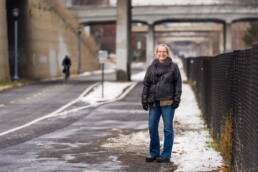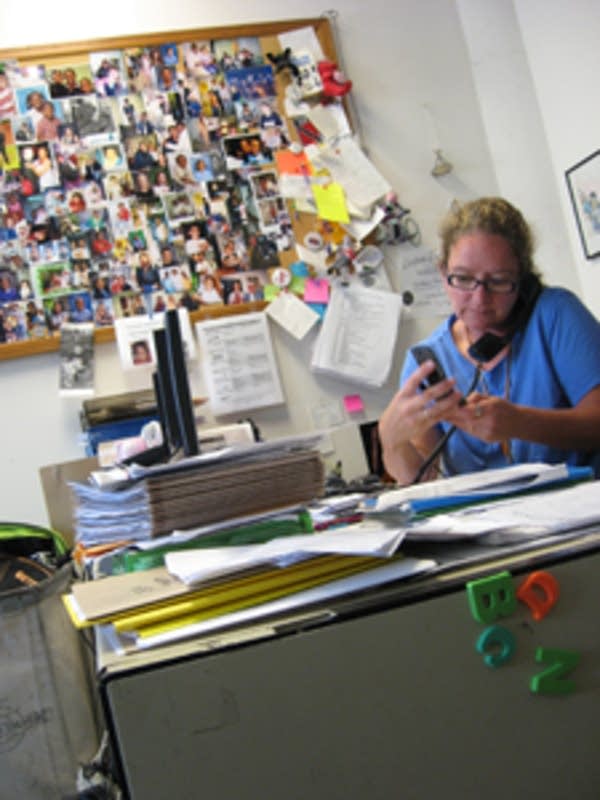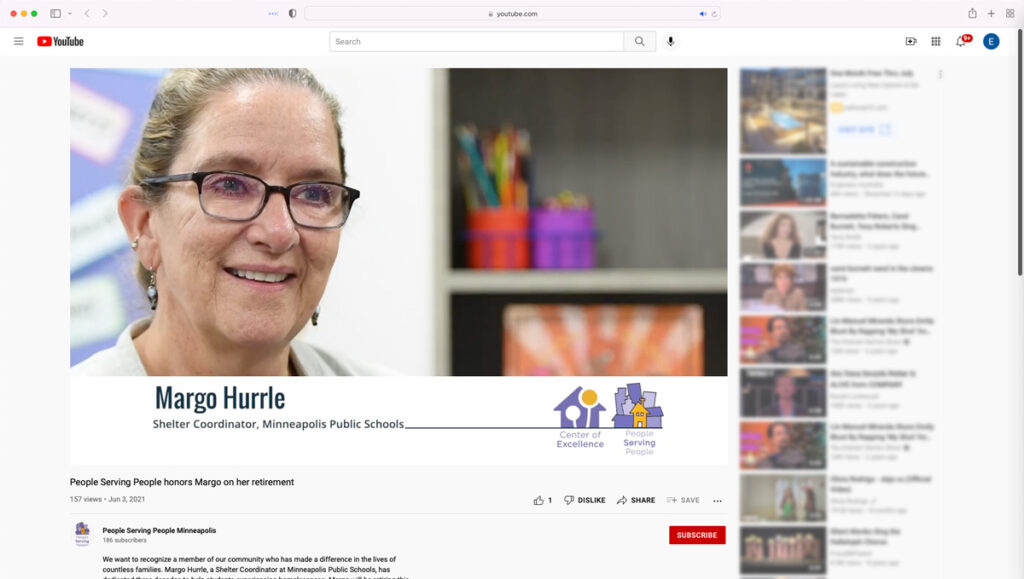We need planned, mindful, intentional housing that meets the needs of those experiencing homelessness. We’ve had a ten-year plan to end homelessness for 20 years. In the city of Minneapolis and in Hennepin County, we can do better. My hope is that we are at a turning point. COVID showed we do have the money to house people, we just need to apply it!
We have the people who can come up with the policy changes—people who know that every child deserves a place to call home.
— Margo Hurrle

Rebellious Childhood in Duluth
I grew up in an intergenerational home in Duluth. My mom and I lived with my grandparents, and they helped raise me. I had no siblings, so I was surrounded by adults. We lived on the east side of the city. My school reflected the neighborhood: upper-middle class and white.
I was a rebellious teenager. I don’t know why. My friends were good rule-followers, and I knew the rules. But I made bad choices. I was a hell-raiser: shoplifting, doing drugs, drinking, and partying. I know this put my family through a lot of stress. I got put into groups for my behavior and drug use, and these interventions helped me get through high school.
Before I graduated from high school, I began volunteering at a youth center with kids who were having behavior and chemical use problems. I could relate to them. At the same time, I saw what a place of privilege I came from. I had the support of family, and the resources to do everything right, and yet I didn’t take advantage of what I had. At the youth center, I worked with kids from the west side, many of whom did not have those resources. That volunteer position probably started me on my path, working with people experiencing homelessness.
I didn’t go to college after high school. I was still rebelling, I guess. Instead, I backpacked for a year through Europe by myself. That was back in the day when it was a common thing to do. Every big European city had a central park where groups of young people were sleeping outside. I picked up odd jobs to make a little money. It was a wonderful time, and again showed me how lucky and privileged I was to have grown up how and where I did.
Working at a Juvenile Boot Camp in Duluth
When I returned, I worked at Woodland Hills in Duluth, a program for first-time juvenile offenders. I was there about four years. It was a boot camp for juveniles: young first-time offenders who, just maybe, we helped turn around. We had kids split wood: foot-long lengths from full-size trees. The idea was to get them outdoors, working on something concrete, learning how to follow directions. The idea was to help them feel good about themselves and build confidence. If you are a tiny eleven-year-old child who just got caught shoplifting in the Twin Cities, but you can lift these logs and make this wood pile, it might give you a sense of your capabilities.

I met my life partner at Woodland Hills. After four years we left the boot camp and spent a year backpacking through Central and South America. At one point we stopped for a month in a small town in Mexico and lived in a one-room bamboo hut. When we came back to the Midwest, homes seemed so big. People need housing: walls—heating systems and such—but the upper-middle class in the U.S. has an over-the-top idea of what is necessary in a home. Traveling to Latin America reinforced my understanding of how lucky I am. The world is so much bigger than my little corner. My problems were small.
Working At St. Joseph’s Home for Children in Minneapolis
After a brief time living on a small, isolated Wisconsin farm, we moved to South Minneapolis, where we’ve lived for the las 35 years. My first job in Minneapolis was at Saint Joseph’s Home for Children, which recently closed. I loved working with youth, and I learned a lot in that job. What I didn’t like was the corporal treatment method. If a kid acted out, especially physically, you were supposed to grab them and hold them until they stopped. Most of the time, it didn’t work. It just made them fight harder. That part of the job was not for me.
McKinney Vento Law and Working with Children Experiencing Homelessness
I left St. Joe’s in 1991 and took a job with the Minneapolis Public Schools (MPS), working with families experiencing homelessness. The McKinney Vento Act , passed in 1987, had just mandated that all school-aged children and youth who were homeless had the right to enroll in public schools. In 1991, extra teeth were put into the law, so that school districts had to hire somebody to ensure these students could be successful in school.
For the next 30 years that was my job: to work in MPS with children and families experiencing homelessness. During this time, I went back to school at the University of Minnesota and got a degree in sociology, and to St. Catherine’s for a nursing degree.

The Thirty-Year Rise in the Number of Children and Adults Experiencing Homelessness in Minneapolis
When I first started the MPS job, homelessness in Hennepin County was different than it is now. Most of the children I worked with were staying in domestic violence shelters. Shelters at that time were for the kinds of people that others still think of when they think of homelessness: single men and a few women—the derogatory phrase was “bag ladies”—people with possible mental health issues, alcoholism, and a shopping-cart full of belongings. Not children.
But in 1991, the 410 Shelter in downtown Minneapolis began to have more children coming in with their parents. The shelter staff would call the school district and ask, “What do we do with these kids? They’re sitting here, not going to school. Where are they supposed to go? Can you send someone down to pay attention to this?”
There was one school social worker who worked with me. I would go to free food sites—places that served hot meals during the day—searching for children who were homeless. Families and children would show up in the middle of the day when the kids should have been in school. I’d put them in my car and drive them to school. That’s how we ran it back in the day. I would transport students to their schools and get them registered.
The first year, we found about 50 children and youth who were school-age. The next year there were more like 250. When I retired this year (2021), there were over 5000 children, birth to 18 years old, from many different school districts, experiencing homelessness in Hennepin County. Before COVID, we had years when shelters were beyond capacity. We would prepare to put families in the lobbies of county buildings overnight. Shelters were bursting at the seams.
Policies Creating the Rise in Childhood Homelessness in Minneapolis
What changed? The safety net changed. Back when I first started this work, getting a Section 8 voucher was fairly easy. You applied and you got one within a few weeks. Certainly, that was the case for the refugee communities at the time. Hmong refugees in the 1980s and the first wave of Somali refugees got a Section 8 voucher when they arrived in the States. Families in domestic violence shelters also received Section 8 vouchers.
Thirty years ago, families who came to the shelter and stayed for a week or two before they found an apartment. Now we see many families experience homelessness for years. The city and county haven’t become poorer; there’s a lot of money, yet families and children struggle just to get housing, which should be an automatic right.
Today there is a long waiting list for Section 8 housing. Before, it was understood that housing was a necessity to be able to move forward. We got folks into housing first and then helped them figure out employment, daycare, schooling. We just don’t do that anymore. Housing is not seen as a necessity, which is insane.
When I first started, I would occasionally find a family in a campground or in the woods in Minneapolis, but it was very seldom. Most families would come into a shelter. But recently this has dramatically changed. Just a few years ago, the encampment on Franklin and Hiawatha was formed, the Wall of Forgotten Natives. The number of children living on that little strip of land was shocking. I think it was a wakeup call for the city. People lived in tents during snowfalls and watched several tents catch on fire. There were needles everywhere you looked. The trauma it caused children will last a long time. Children watched as neighbors overdosed and had to be revived. We were sending school buses to the corner by the camp and trying to get the kids to school every day.
The Lack of Housing Affects Everything
The trauma that children go through with every single move—leaving behind friends, leaving behind pets, leaving behind favorite toys—is tremendous. In 30 years I’ve seen three generations of some families without stable housing. Not having stability becomes the norm for a child who grows up homeless. That is unacceptable.
Living in a homeless situation—a shelter, a tent, a car, doubled up with friends or family or a hotel—children are never sure if the place they are staying will be available when they get home from school. Will the tent be torn down, will the shelter make them leave, will they run out of money for the hotel? The stress of not having stability causes anxiety, fear, and missed school days. We see parents keep children home from school because even they aren’t sure where they might be sleeping that night.
Assignments that seem basic to teachers can be impossible for kids without stable housing. Like making a collage. How do you do that in your car, a tent, or a hotel? There are no magazines or newspapers. You may not even have a pair of scissors. Only the most essential things came with you from the last apartment. While most shelters have resources to help with schoolwork you still need the courage to ask for help or know the resources available. We have had teachers concerned that students aren’t showing up with the basics they are asked to bring to school, a pencil, a notebook, etc.
Imagine how hard it is to find a pencil if you are sleeping in a car every night with your family and all your belongings.
I remember service groups coming to shelters and giving children brand new books. They put little name tags inside the books and sat with the children as they picked out their books and then had them write their names in the books, thinking this was going to be a treasure. The group would leave, and days later I could find these books laying in the parking lot, smashed on the ground. It’s not because the kids and the families weren’t appreciative. It was because they’ve learned: don’t become attached to anything, because it will be gone in a minute. You can’t have a favorite book or a favorite stuffed animal because it’s too painful to lose.
Sometimes the social stigma, real or perceived by the student, interrupts a student’s progress. I remember a young lady who wanted to be on the basketball team. She thought she would never be able to because she couldn’t make it to practices while living in a shelter. We said “Sign up. Get on that team. We will taxi you to every practice.” We did. Every practice, every game. Everything was good until the group of girls on the team decided they wanted to all get matching warm-up sweatpants. Of course, she didn’t have any money. Instead of letting us know, she quit the team. She didn’t feel like she could ask us for the money to buy the sweats and she just didn’t want to be that odd girl out.
And then there is the shame students feel when they get into high school and middle school, about staying in shelters. Students ask us if they can get on the bus two blocks away because they are embarrassed to get on in front of the shelter. We always try to make all shelter stops the first pick-up and last drop-off. Sometimes students will leave the family to get out of the shelter, staying with friends or relatives. Often that means they are unsupervised, and that leads to other trouble.
These issues are compounded for students living in tents.
School can begin to feel less and less important to youth who are old enough to be very aware of their parents’ struggles. The number of youths in high school and middle school who get jobs to help parents out financially is great among kids without housing stability. Soon the job feels more important than school; unfinished homework and credits pile up. Many youths drop out.
Policy Prescriptions
If you build a big apartment building downtown, you better make a percentage of the apartments truly affordable. I don’t understand the large management companies. They are making plenty of money. With all the new housing being built throughout the city and county, we need to mandate percentages of units that are truly affordable to families with low incomes.
We need rent control. A case in point: a family I recently worked with had a three-year subsidy in a nice complex near Uptown. The subsidy was ending in two months and the rent was going to increase by $900! The program got the family out of shelter, giving them three years of stability, but now here they come back into the homeless system again! Why can’t the apartment building managers suck it up? They’re charging enough for the other apartments in the building. Why can’t they offer a few other units of affordable rent?
We also need to be thoughtful about where people want to live and where supportive communities are located. There are good housing programs that are affordable and we’re grateful for that. But some of them are not meeting the needs of people they serve. An example is a large, beautiful townhome complex in a third-ring suburb. There is no public transportation from the city to that suburb, so the families have difficulty keeping in touch with resources. The schools out there are not diverse, and the children report feeling uncomfortable.
Beyond that, childcare assistance is greatly needed. 90% of the families that I worked with in shelters over the years worked full time jobs. If you take three days off with a sick child, and you work at a service industry job, you risk being let go. I believe finding quality and affordable daycare is a barrier to keeping employment. We need universal daycare and universal health care. It’s about children’s rights. Other countries have managed to do this, and we know the money is there to do it.
Helping people in need now (especially children) will lead to better outcomes for the future. We should be thinking of the long-term gains that individuals and our community could make if people were housed and safe.
Policy Changes in Hennepin County Could Eliminate Local Homelessness
We don’t have to wait for federal changes. We could make these changes in housing, childcare, and health care availability in our community. We could move the money around. Hennepin County did a study of the 100 people without homes who were the highest users of homeless shelters and county services. These totaled many thousands of dollars a year per person, all for things that could have been prevented if the person had a home. The study showed that housing people costs less than maintaining the current system.
Is affordable housing going be the answer for everyone? No, there are certainly other barriers that come into play. But most families I’ve worked with in shelters would thrive if they only had a place that’s safe and affordable. Housing first. Then mental health or chemical dependency assistance, or whatever secondary problems exist.
Homelessness in Minneapolis since 2020
COVID showed we do have the money to house people, we just need to apply it!
In 2020, when Powderhorn and many other parks filled with families and children, I was hopeful people would realize children should not be sleeping in tents, that housing is most important.
Since the pandemic began, the number of families staying in shelters decreased greatly. I believe this was due to the eviction moratorium, COVID funds that were given out, and local efforts at keeping people out of congregate settings during a pandemic. As a result, in September 2021, one of the main shelters was maybe 1/4 full and the other one about 2/3 full. That’s unprecedented in the last ten years.
For the past year we had many families in hotels, paid for not only by county and state funds, but by private entities. So the money is there, just not the willingness to house people permanently, in a home.

My Next Steps
We need planned, mindful, intentional housing that meets the needs of those experiencing homelessness. I have spent years working on this issue on a micro level. I’d love someday to attack the problem from the macro level. We’ve had a ten-year plan to end homelessness for 20 years. We’ve made lots of grand statements and some progress, but in my heart of hearts I know that, in the city of Minneapolis and in Hennepin County, we can do better.
My hope is that we are at a turning point right now. We have seen that we have the money. We have the people who can come up with the policy changes and get these changes implemented—people who know that every child deserves a place to call home and feel safe.

